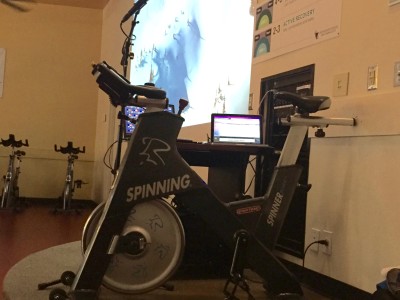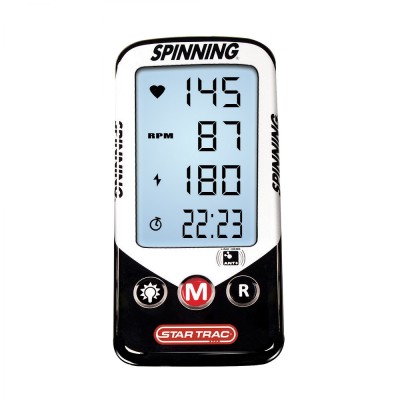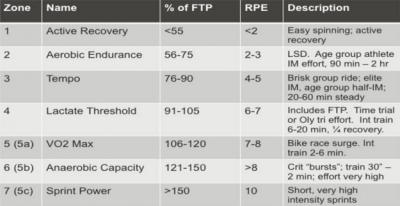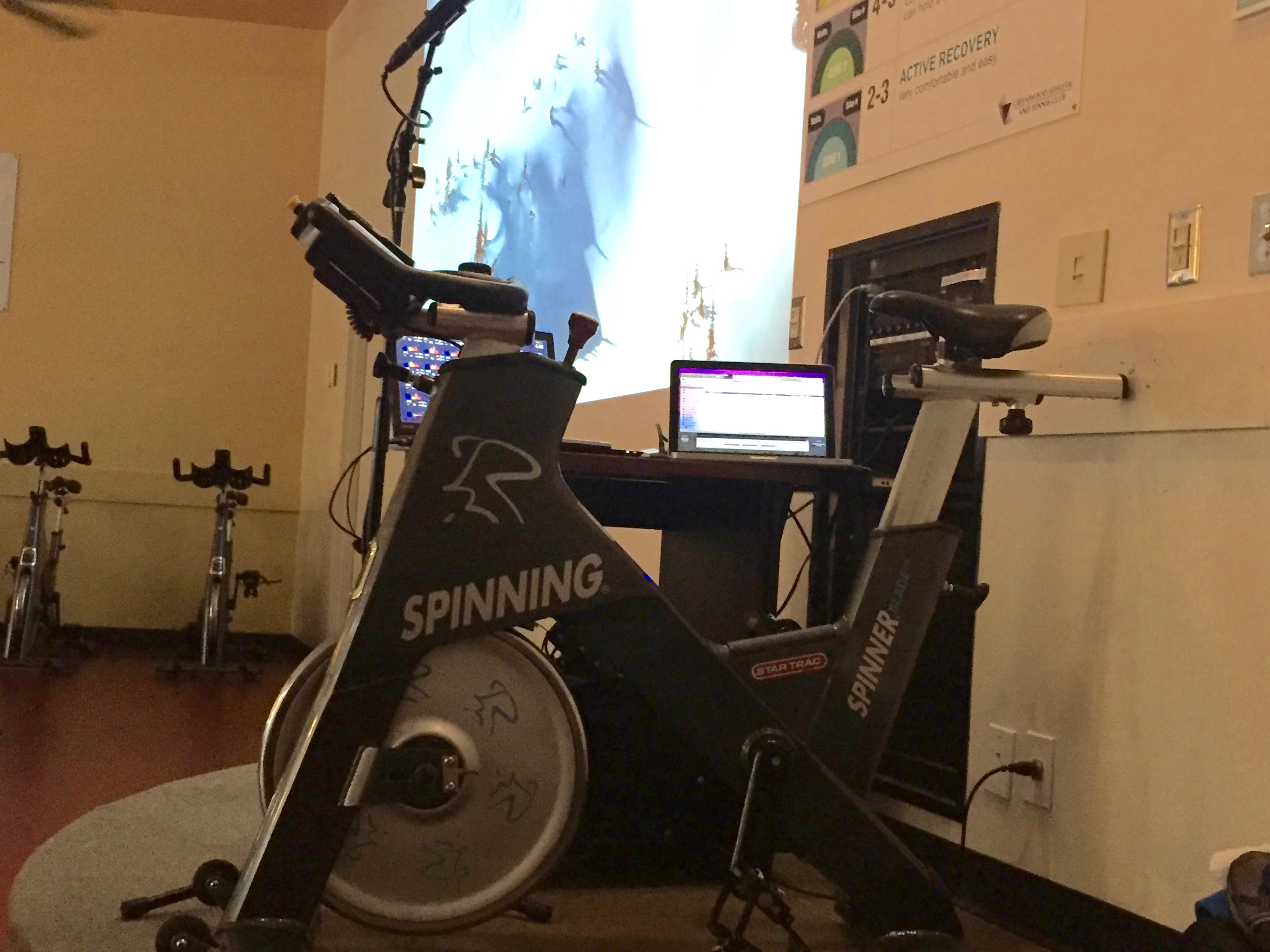
Today I ended a turbulent 3 year relationship with the Spinner Blade Ion. A courtship that began with high aspirations for a long, happy and powerful future has deteriorated into one complication after another and I no longer have the energy to keep the blue light burning.
About 3 years ago management announce that we were going to be the first club in the United States to receive the brand new Spinner Blade Ions, this was Spinning's first foray in the new world of power. Though I personally was hoping for a different choice I was excited to finally be teaching on a bike that would express work output in watts. Now instead of spending so much time cuing how each interval should feel I was going be able to use each rider's personalized power zones. The idea of personalized training zones is not new, the fitness industry has been trying to use them with heart rate for nearly 25 years. The problem with heart rate training is that all participants need to be using heart rate monitors for it to be effective and as any experienced fitness professional knows we are lucky to have 20% of our participants wearing monitors in any class. The beauty of leading a power based indoor cycling class is that ALL participants have a power meter on their bike!
A few weeks before delivery the instructors started receiving various training manuals and information about the features of this new bike. This is when I started getting worried. The first problem I saw was the continued use of a chain. Why would any new bike continue to use a chain when belts, both Poly V and Carbon Drive, have proven to be a much better option. Belts don't stretch or break, they are so strong that many motor cycle manufactures use them. The second flaw I noticed was the continued use of a friction breaking or resistance system. Friction resistance has been the bane of instructors and bike techs since the inception of indoor cycling. I still remember the days of walking around the cycling room with a bottle of silicon lubricant spraying the squeaky brake pads then having to endure the smell of the same burning silicon. There were also the times I would sweat or spill water, from my water bottle, on the flywheel and lose most of my resistance. Why would anyone want to build a new bike with old friction resistance technology when magnetic resistance has been proven to be so much better. I'm not an engineer but the only time I can think that excessive friction is a good thing is when trying to build a fire. The third and final concern I had when looking through these training manuals was the console. The layout was, to be honest, stupid!

First, why would you not put wattage on the top? The new and special aspect of these bikes was power, why would you hide it in the middle? Why give heart rate the most prominent line on the console when so few people actually wear heart rate monitors? Also, any instructor with 1 month's experience teaching with power understands the importance of seeing real time AND average wattage when performing intervals. Why are they not available on the same screen? The only way to see average wattage on this console is to push the "M" button and scroll through the four different screens, something everyone wants to do when they are working hard. The word "Simple" kept coming up in the literature. Well when it comes to console design, I think Simple=Stupid. After the initial learning period of how to use power, participants and instructors want a console that gives them all the metrics they need to take and teach an effective class not a simple one. Finally, this bike was being released at the beginning of the wearables craze. Everyone wanted to track and log every aspect of their workout. With the Spinner Ion Blade there was no way, beyond taking a picture of the console, to track your workout, no USB port, no phone app, no open protocol that would let the console communicate with the many fitness apps that were available. I teach in Denver Colorado, the riders here are some of the most sophisticated indoor and outdoor riders in the world, they know power and want a way to use it to it's fullest potential. If there isn't a way to track real time wattage throughout a ride there is no way to determine Normalized Power, Intensity Factor or Training Stress Score. Again, Simple=Stupid.
So, the bikes finally arrive and EVERYONE was so excited! We had been riding Spinner NXT bikes and these new Ions felt very familiar but what everyone was psyched about was the power. I had been lucky enough to be teaching with power for a few months on the Keiser M3 and the Freemotion bike. I've also been coaching some athletes who use power meters and I've read Hunter Allen and Andy Coggan's Training and Racing with a Power Meter. So I felt like I had a pretty good understanding of how power works. On my very first ride I noticed something very disturbing, my wattage was 20-40 watts lower on these bikes then the M3 and Freemotion bikes and people who were riding with power on their outdoor bike were noticing the same thing. Then, as I rode different bikes I found huge wattage variations from bike to bike. Understanding that this was a very subjective test a few instructors decided to ride ALL 56 bikes while wearing heart rate monitors. We would work up to a specific heart rate that was in our Aerobic Zone then take note of the wattage. This wasn't the most scientific test, but it was the best we could do without being able to hook the bikes up to a dynamometer. The results were SHOCKING! More than half the bikes weren't even close to each other, they varied by as much as 100 watts. We explained this issue to the bike manufacture and asked if there was a way to recalibrate the bikes in order to assure consistency from bike to bike. The answer we received was even MORE shocking then the amount of bike to bike variation. THERE WAS NO WAY TO RECALIBRATE THE POWER. Are you kidding me? Every indoor cycling bike whether direct power or measured and every outdoor power meter has a way to recalibrate! This was our "Oh Shit" moment and when I started thinking of "work arounds" to this fatal flaw.
The foundation of training and coaching with power is finding one's FTP, Functional Threshold Power. This is simply the maximum power a rider can average for 1 hour. Since a one hour test would not be practical in most indoor cycling settings the next best test is a 20 minute "best effort" ride where 95% of the 20 minute average wattage is calculated as the FTP. We then use the FTP to determine power training zones.

Since the variation from bike to bike could be as much as 100 watts, unless I could guarantee that every rider would be able to ride the same bike in ever class the FTP test results were useless. So my workaround was to perform a modified FTP test at the beginning of every class. This way we could find an estimated FTP for each rider on each bike for each class. I would cue what threshold was supposed to feel like, have my class ride at that "feeling" and take note of the wattage their bike read when they "felt" like they were at threshold. Unfortunately this was not very scientific but it was the best I could do in the situation we were in. At least this let me speak the language of power and riders could be accountable from interval to interval even if the numbers weren't exactly correct.
As I gained more and more experience teaching with power I realized the importance of Average Wattage when coaching interval based profiles. If riders are told to focus on average wattage for each interval, they are forced to work for the full length of each interval. Riders learn very quickly if they "sandbag" the beginning of an interval they need to work extremely hard at the end of it to reach their goal average wattage. Many of the top indoor cycling bikes with power show real time and average wattage on the same screen, not the Ion. Riders have to cycle through the four available screens to see real time and/or average watts.
The power meter and the console were by far the two biggest mistakes made with the Ion, but there were more. The friction resistance was a problem that was made obvious when combined with the use of a power meter. Friction causes heat and heat causes the brake pad to work less efficiently, so if I asked my riders to find specific wattage and rpm and to hold it for a few minutes over time the brake pad would heat up, work less efficiently and wattage would drop. Riders were constantly forced to adjust their resistance throughout each interval to maintain current or goal power output. Threadless (Morse Taper) pedals became a problem since they were virtually impossible to remove. Chain instead of belt also added to maintenance requirements and the inability to capture workout metrics through a usb storage device or app became very frustrating to our riders who wanted to track their progress.
The breaking point came when we added a group display system, Performance IQ. These systems display metrics on a TV or are projected onto a screen. Now every rider's metrics were visible for the world to see. It quickly became obvious that we had to do something about the incredible variation in wattage numbers from bike to bike. Now that we were focused exclusively on wattage we needed to find a bike that was much more accurate and consistent so our leader board, races and zones displayed correct metrics.
I'm happy to report that on March 30th we are receiving a shipment of 46 Stages SC3 indoor cycling bikes and these problems should be a thing of the past.
So, as I bid farewell to my Spinner Blade Ion, a bike that I have sat on for nearly 1000 hours over the past 3 years, I am a bit sad. It's not the Ion's fault that this relationship didn't work out. Maybe it was a rush to market, lack of foresight, not realizing that Simple = Stupid, or just plain ego that let it arrive in my club with all these fatal flaws. I'm thankful that it challenged me to become a better instructor by working through all it's various issues, but eventually it became exhausting and I just don't have the will to keep the blue light burning anymore.
- Having Problems Downloading the Massive Amount of Free Media On ICI/PRO? - July 11, 2024
- Simple and Progress Profile for July #1 – Hang On - June 29, 2024
- Simple and Progress Profile for May #1 – “How Far Can You Go?” - April 30, 2024

